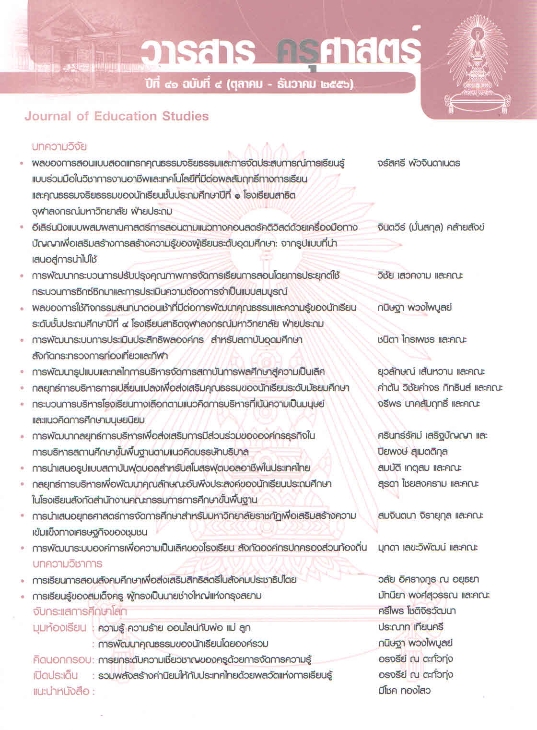อีเลิร์นนิงแบบผสมผสานศาสตร์การสอนตามแนวทาง คอนสตรัคติวิสต์ด้วยเครื่องมือทางปัญญาเพื่อเสริมสร้าง การสร้างความรู้ของผู้เรียนระดับอุดมศึกษา : จากรูปแบบ ที่น
Abstract
บทความนี้นำเสนอรูปแบบอีเลิร์นนิงแบบผสมผสานศาสตร์การสอนตามแนวทางคอนสตรัคติวิสต์ด้วยเครื่องมือทางปัญญาเพื่อเสริมสร้างการสร้างความรู้ของผู้เรียนในระดับอุดมศึกษา ประกอบ ด้วย รูปแบบทั่วไป ๑ รูปแบบประกอบด้วย ๓ องค์ประกอบ ได้แก่ (๑) บทบาทผู้สอน/บทบาทผู้เรียนเชิงรุก (๒) กิจกรรมด้วยเครื่องมือทางปัญญาและ (๓) การประเมินผลในรูปแบบชิ้นงานและกระบวนการ และ ๓ ขั้นตอน ได้แก่ (๑) ขั้นนำ (๒) ขั้นสอน และ (๓) ขั้นสรุป ในขณะที่รูปแบบเฉพาะจำนวน ๓ รูปแบบ ประกอบด้วย ๔ องค์ประกอบ ได้แก่ (๑) บทบาทผู้สอน/บทบาทผู้เรียนเชิงรุก (๒) กิจกรรมด้วยเครื่องมือ ทางปัญญา (๓) การผสมผสานศาสตร์การสอน และ (๔) การประเมินผลในรูปแบบชิ้นงานและกระบวนการ และ ๓ ขั้นตอนหลักอันประกอบด้วย ๗ ขั้นตอนย่อยที่สอดคล้องกับรูปแบบทั่วไปและปรับเฉพาะ ตามศาสตร์การสอนแต่ละประเภท โดยศาสตร์การสอนประกอบด้วย การเรียนออนไลน์โดยใช้วิธีการ อภิปรายร่วมกันกับการเรียนรู้แบบร่วมมือ การเรียนออนไลน์โดยใช้วิธีการเรียนแบบโครงการเป็นหลัก ร่วมกับการเรียนรู้แบบร่วมมือ และการเรียนออนไลน์โดยใช้วิธีการแก้ปัญหาร่วมกันกับการเรียนรู้ แบบร่วมมือ ในส่วนท้ายจะเป็นการนำเสนอแนวทางการนำไปใช้ ประกอบด้วยโปรแกรมประยุกต์ สำหรับพัฒนาเครื่องมือทางปัญญาต่างๆ ที่นำมาผสมผสานกับศาสตร์การสอน เพื่อนำสู่การเรียนการสอน ที่มีประสิทธิภาพ อันจะส่งต่อประสิทธิผลของผู้เรียนต่อไป
This article presents the model of pedagogical blended e-learning using cognitive tools based upon a constructivist approach for knowledge construction of higher education students. The model included one generic model with three sub models for learners to effectively construct their knowledge. The generic model included three elements: (1) instructor’s and learners’ active roles, (2) activities with cognitive tools, and (3) assessment of the process and the product; while the procedures of the generic model included three steps: (1) pre-instruction, (2) instruction, and (3) evaluation. Regarding the specific models, all three were comprised of the 4 elements including (1) the instructor’s and learners’ active roles, (2) activities with cognitive tools, (3) pedagogical based activities, and (4) assessment with process and product; while the 3 procedures with 7 steps each were customized according to the pedagogy applied to each model. The pedagogy included Collaborative Discussion-Based Learning (CDBL), Collaborative Project-Based Learning (CPjBL), and Collaborative Problem-Based Learning (CPBL). In addition, the last part of this article focuses on how the proposed model could be applied including the application programs for developing various types of cognitive tools integrated into the pedagogies. Hence, the effectiveness of instruction would be emerged which will further result learning efficiency.




